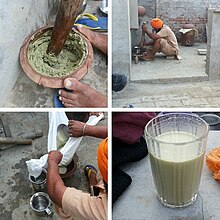Cannabis and Sikhism

In Sikhism, some Sikhs particularly of the Nihang community use edible cannabis in a religious context. They make use of Bhang, which is an edible preparation of cannabis made of the leaves and the seeds of the plant.
Prohibition[]
The first Sikh guru, Guru Nanak, stated that using any mind altering substance (without medical purposes) is a distraction from God. Guru Nanak was offered bhang by the Mughal emperor Babur; Nanak however declined, and recited this shabad:
Fear of Thee, o Lord, is my bhang, and my mind the pouch in which I carry it. Intoxicated with this bhang I have abandoned all interest in worldly concerns.[2]
Usage[]
The Sikhs inherited the tradition of drinking bhang from Hindu culture, and the Sikh holiday Dasehra, in honor of the Third Guru, is celebrated with bhang.[3][4][5][6]
Nihang Sikhs[]
In the modern day, bhang consumption (but not smoking) is commonly associated with the Nihang Sikhs, a sect who continue the Sikh warrior tradition, who consume bhang edibles or drinks as sukha or sukhnidhaan.[7][8] Bhang is mostly used in India on the Sikh holidays of Holla Mohalla and Vaisakhi. At many Sikh temples, including Takht Sachkhand Sri Hazur Sahib Ji, the sukhnidhaan is offered as a holy food.[9]
In 2001, Baba Santa Singh, the jathedar of Budha Dal, along with 20 Nihang sect chiefs, refused to accept the ban on the consumption of bhang by the highest Sikh clergy.[10] Baba Santa Singh was excommunicated for a different issue, and replaced with Baba Balbir Singh, who agreed to shun the consumption of bhang.[11]
Some Nihang groups consume cannabis or shaheedi degh (ਭੰਗ) , purportedly to help in meditation. Sukhaa-parsaad (ਸੁੱਖਾਪ੍ਰਰਸਾਦ), "dry-sweet", is the term Nihang use to refer to it. It was traditionally crushed and taken as a liquid, especially during festivals like Hola Mohalla.
References[]
- ^ Ayyagari S (2007). ""Hori Hai": A Festival of Colours!! (review)". Asian Music. Johns Hopkins University Press. 38 (2): 151–153. doi:10.1353/amu.2007.0029. S2CID 192201145.
- ^ McLeod (4 March 2004). Sikhs and Sikhism: Comprising Guru Nanak and the Sikh Religion, Early Sikh Tradition, The Evolution of the Sikh Community, Who is a Sikh?. OUP India. pp. 74–75. ISBN 978-0-19-566892-6.
- ^ Jeffrey Winterborne (2008). Medical Marijuana Cannabis Cultivation: Trees of Life at the University of London. Pukka Press. pp. 294–. ISBN 978-0-9550112-2-1.
- ^ E.L. Abel (29 June 2013). Marihuana: The First Twelve Thousand Years. Springer Science & Business Media. pp. 128–. ISBN 978-1-4899-2189-5.
- ^ Hemp Drugs Commission, India (1894). Report, 1893-94. pp. 162–.
- ^ Joseph Thackwell (1851). Narrative of the second Sikh war in 1848-49. With a detailed account of the battles of Ramnugger, the passage of the Chenab, Chillianwallah, Goojerat, &c. ... Second edition, revised with additions. Richard Bentley. pp. 181–.
- ^ Pashaura Singh; Louis E. Fenech (March 2014). The Oxford Handbook of Sikh Studies. OUP Oxford. pp. 378–. ISBN 978-0-19-969930-8.
- ^ Pashaura Singh; Michael Hawley (7 December 2012). Re-imagining South Asian Religions: Essays in Honour of Professors Harold G. Coward and Ronald W. Neufeldt. BRILL. pp. 34–. ISBN 978-90-04-24236-4.
- ^ "The 'Sukhnidhaan' or 'Bhang' (cannabis)". Amrit World. Retrieved 19 November 2015.
- ^ Nihangs ‘not to accept’ ban on bhang. The Tribune. March 26, 2001.
- ^ No ‘bhang’ at Hola Mohalla. The Tribune. March 10, 2001.
- Cannabis and Sikhism
- Cannabis in India
- Cannabis culture